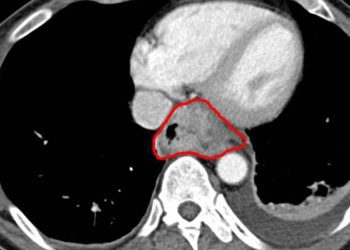2 Minute Medicine Rewind September 26, 2022
1. In this randomized controlled trial, complete revascularization of eligible lesions in percutaneous coronary intervention (PCI) resulted in a significant improvement in patient-reported quality of life versus revascularization of culprit-only lesions in patients with an ST-elevation myocardial infarction (STEMI) undergoing treatment.
Evidence Rating Level: 1 (Excellent)
In patients who present with ST-elevation myocardial infarction (STEMI), multivessel coronary artery disease (CAD) is common. Previous studies have showed that complete revascularization in STEMI reduces cardiovascular events, due to reduced rates of ischemia-driven revascularization. The current guidelines based on previous research recommend complete revascularization with staged percutaneous coronary intervention (PCI) to reduce risk of death or myocardial infarction in patients with STEMI and multivessel CAD. However, there is a lack of high-quality evidence investigating the effect of complete revascularization on patient-reported quality of life. The Complete vs Culprit-Only Revascularization Strategies to Treat Multivessel Disease After Early Percutaneous Coronary Intervention (PCI) for STEMI, or the COMPLETE trial, was a multinational clinical trial that compared complete revascularization with PCI of all suitable, non-culprit lesions versus PCI of only culprit lesions from 140 primary PCI centers in 31 countries. The primary outcome was patient CAD-related health status, measured using the Seattle Angina Questionnaire (SAD), which assesses frequency of angina, treatment satisfaction, angina stability, physical limitations, and quality of life, with higher scores indicating better disease-specific health status and fewer symptoms. This questionnaire was given to patients at baseline, near or at randomization, 6 months after randomization, and at their final visits, which was a median of 36 months after randomization. Between February 2013 and March 2017, 4041 patients were randomized, 2016 to complete revascularization of all suitable non-culprit lesions, and 2025 to PCI of the culprit lesion only. With respect to the main outcomes, the SAQ-AF (angina frequency) score was increased significantly from baseline in both groups (P<.001), and the complete revascularization group had a significantly higher score than the culprit-lesion only group (difference 0.97 [95% CI, 0.27-1.67]; P=.006). The SAQ summary score, which was an overall measure of angina-related health status, was also increased significantly increased in the complete revascularization group compared to the culprit lesion group at both 6 months and final follow-up. With respect to freedom from angina, at 3 years follow-up, the complete revascularization group had a significantly higher proportion that were free of angina when compared to the culprit-lesion only group (absolute difference, 3.21% [95% CI, 0.69-5.73%]; P=.01). A major limitation of this study was that 14% of health status measurements were missing from the final encounter from each group, which increases the risk of type II error. Overall, the main COMPLETE trial showed that complete revascularization reduced major cardiovascular events compared with culprit lesion-only PCI. This secondary analysis showed that there was not only an improvement of cardiovascular outcomes, but also a significant improvement in patient-reported quality of life as per the SAQ, including number of patients completely free from angina, as well as the overall summary score. These findings may help guide clinicians in future clinical decisions regarding revascularization in patients who experience a STEMI.
1. In this cohort study, perioperative gabapentin for multimodal analgesia in older adults undergoing major surgery was associated with an increased risk of delirium, new antipsychotic use, and pneumonia.
Evidence Rating Level: 2 (Good)
Following surgery, multimodal nonopioid analgesia is being used more frequently, with high quality evidence showing improved pain control and decreased opioid use associated with multimodal analgesia. Gabapentin is recommended as a component of nonopioid analgesia; however, recent studies have raised concerns about marginal benefits and possible side effects including perioperative delirium. This retrospective cohort study aimed to investigate the association of perioperative gabapentin use with adverse effects in older adults undergoing major surgery. This study included adults aged 65 years or older from the Premier Healthcare Database, which covers approximately 25% of annual inpatient admissions in the US, who underwent major surgeries within 7 days of hospital admission. The primary study outcome was delirium, as per the diagnostic code, and secondary outcomes include new antipsychotic use, pneumonia, and in-hospital death. In total, 967,547 patients were eligible to initiate gabapentin for perioperative pain management, and 119,087 (12.3%) received gabapentin in the perioperative period. With respect to the primary outcome, after propensity score matching, gabapentin users had an increased risk of delirium (4040 [3.4%] vs 3148 [2.6%]; RR, 1.28 [95% CI, 1.23-1.34]; RD, 0.75 [95% CI, 0.61-0.89] per 100 persons), new antipsychotic use (944 [0.8%] vs 805 [0.7%]; RR, 1.17 [95% CI, 1.07-1.29]; RD, 0.12 [95% CI, 0.05-0.19] per 100 persons), and pneumonia (1521 [1.3%] vs 1368 [1.2%]; RR, 1.11 [95% CI, 1.03-1.20]; RD, 0.13 [95% CI, 0.04-0.22] per 100 persons) when compared to gabapentin nonusers. There was no significant difference in in-hospital deaths between gabapentin users and nonusers. With subgroup analysis, the associations of gabapentin use with delirium, new antipsychotic use, and pneumonia were consistent. A major limitation of this study was the use of diagnostic codes, which is better at identifying hyperactive delirium, typically associated with a poorer outcome than hypoactive or normoactive delirium, which may result in type II error. Overall, perioperative gabapentin use was associated with an increased risk of delirium, new antipsychotic use, and pneumonia, but not in-hospital death in adults aged 65 years or older after a major surgical procedure. Previous research has encouraged the use of multimodal analgesia following surgery, including gabapentin, but the findings of this study suggest that use of gabapentin perioperatively for pain control increases the risk of adverse events. As a cohort study, study findings are limited in their interpretation, but provide valuable preliminary findings that may hopefully cause clinicians to rethink gabapentin use, especially in older adults at high risk of delirium (i.e., previous cognitive impairment).
Operative vs Nonoperative Treatment of Acute Unstable Chest Wall Injuries
1. In this randomized controlled trial, there was no significant difference in ventilator-free days (VFDs) in the first 28 days after injury in patients who received either operative or nonoperative treatment for an unstable chest wall injury.
2. In patients who were mechanically ventilated at the time of randomization, operative treatment resulted in a significantly shorter length of in-hospital stay versus nonoperative treatment.
Evidence Rating Level: 1 (Excellent)
Chest wall injuries causing instability from blunt chest trauma have high rates of mortality and morbidity; with high incidence of complications including chest wall instability and pulmonary complications. The most prevalent treatment is nonoperative, including intubation, positive pressure ventilation, pain control, and chest physiotherapy. However, this nonoperative approach may not produce optimal results. Previous research has reported improved outcomes with an operative versus nonoperative approach, but there is a paucity of high-quality randomized-controlled trials comparing these approaches. This multicenter, prospective, randomized controlled trial compared operative treatment of unstable chest wall injuries with nonoperative management. Patients were randomized to either receive operative or nonoperative treatment of their chest wall injury. The primary outcome was the number of ventilator-free days (VFDs) during the first 28 days following injury. 211 patients were recruited from 15 level 1 trauma centers across Canada and the United States from October 2011 to September 2018 meeting an indication for surgical fixation of chest wall injury. 111 patients were randomly assigned to receive operative treatment, and 100 patients were randomly assigned to receive nonoperative treatment. With respect to the primary outcome, mean VFDs were 22.7 days for the operative group, and 20.6 days for the nonoperative group (mean difference 2.1 days; 95% CI, -0.3 to 4.5 days; P=.09). However, in patients who were ventilated at the time of randomization, operative treatment reduced length of stay in hospital (HR, 1.4; 95% CI, 0.9 – 2.1) when compared to nonoperative treatment, while the number of VFDs were still similar between the two groups. There were no statistically significant differences between the two groups with respect to VFDs or number of days receiving mechanical ventilation. For secondary outcomes, there were no differences in length of hospital or ICU stay between groups, similar rates of complications, and rates of pneumonia, sepsis, and tracheostomy. A major limitation of this study was the sample size; though it was one of the largest randomized controlled trials to date of this type, it was underpowered to detect statistical significance in certain outcomes. Overall, the findings of this study suggest no difference in operative versus nonoperative treatment in patients with acute unstable chest wall injuries with respect to VFDs and complications. However, within the subgroup analyses, there was a possible benefit of operative treatment in patients receiving mechanical ventilation at the time of randomization, resulting in a significantly shorter in-hospital stay. Further investigation is required, particularly more randomized controlled trials, to adequately compare operative versus nonoperative treatment in acute unstable chest wall injuries.
Association of Empagliflozin Treatment With Albuminuria Levels in Patients With Heart Failure
1. In this post-hoc analysis of a randomized controlled trial, empagliflozin use in patients with heart failure (HF) was associated with decreased rate of new onset macroalbuminuria and increased rate of sustained remission from macroalbuminuria, which is an important variable in assessing severity of chronic kidney disease.
Evidence Rating Level: 1 (Excellent)
Albuminuria, defined as spot urine albumin-to-creatinine ratio (UACR) is an important indicator of structural damage of glomerular filtration barrier, and is key in assessing chronic kidney disease. Previous studies have shown benefits of angiotensin-converting enzyme inhibitors (ACEi) and angiotensin receptor blockers (ARBs) in reducing albuminuria. Furthermore, sodium glucose cotransporter-2 inhibitors have been shown to reduce the progression of albuminuria to macroalbuminuria in patients with diabetes and CKD, with and without diabetes. Research has shown that macroalbuminuria in patients with heart failure is associated with increased risk of hospitalizations and mortality. Using data from the Empagliflozin Outcome Trial in Patients With Chronic Heart Failure with Reduced Ejection Fraction (EMPEROR-Reduced) and Empagliflozin in Heart Failure with a Preserved Ejection Fraction (EMPEROR-Preserved), known as EMPEROR-Pooled, the association of empagliflozin with albuminuria was studied. EMPEROR-Pooled was an international multicenter randomized double-blinded, placebo-controlled trial that enrolled patients with chronic heart failure. Patients were randomized in a double-blind manner to receive placebo or empagliflozin, and albuminuria was assessed using UACR at weeks 4, 12, 32, 52, and every 24 weeks afterward. The primary outcome was both cardiovascular death or heart failure (HF) hospitalization. 9,673 patients were included in this study; 5552 patients had normoalbuminuria (UACR < 30 mg/g), and 1025 patients had macroalbuminuria (UACR > 300 mg/g). Treatment with empagliflozin was associated with a reduction in the incidence of new macroalbuminuria (P=.005), which was consistent across subgroups. Furthermore, among the patients with existing macroalbuminuria, empagliflozin was associated with an increased rate of remission to normoalbuminuria or microalbuminuria (P=.009). However, empagliflozin was not significantly associated with relative changes in UACR over time in the overall population. A major limitation of this study was that the physiological mechanism through which empagliflozin reduces albuminuria could not be determined, which may cause hesitance among physicians. Overall, the findings from this post-hoc analysis suggest that empagliflozin was associated with a decreased rate of new onset macroalbuminuria, and an increased rate of sustained remission to normoalbuminuria or microalbuminuria in patients with heart failure across all subgroups. Empagliflozin was also associated with improved cardiovascular and kidney outcomes irrespective of baseline UACR. This post-hoc analysis supports use of empagliflozin in patients with heart failure, across all types of albuminuria, and will hopefully guide future clinical practice in early use of empagliflozin to prevent progression of kidney disease.
Effectiveness of Stand-alone Telephone-Delivered Intervention for Reducing Problem Alcohol Use
1. In this randomized controlled trial, in participants with problem alcohol use, individuals in the active control group, receiving brief check-ins, and the intervention group, receiving telehealth cognitive and behavioural interventions, both experienced a significant decrease in alcohol use severity 3 months after randomization.
2. The intervention group showed a significantly greater reduction in alcohol use than the active control group.
Evidence Rating Level: 1 (Excellent)
Alcohol use is a leading cause of preventable morbidity and mortality, but there is a sharp contrast between its prevalence and the use of alcohol treatments. This treatment gap is attributable to the multiple individual and structural barriers that exist, and especially since the pandemic, access to treatment has been further disrupted. Telehealth has the potential to overcome many of the barriers to accessing treatment and has been previously studied in smoking cessation with great success. There is a lack of high-quality evidence surrounding telehealth in the treatment of alcohol use disorders, and the purpose of this single-site, double-blind, parallel-group randomized controlled trial was to examine the effectiveness of a telephone-delivered treatment, Ready2Change, in reducing alcohol use in patients with alcohol use problems. Participants 18 years or older with problem alcohol use (as per the Alcohol Use Disorders Identification Test (AUDIT) score), were recruited from Australia using social media between May 2018 and October 2019. Participants were randomized in a 1:1 ratio to the intervention group or control group. The intervention group received 4-6 sessions of telephone-delivered intervention, while the active control group received 4 telephone check-ins from a researcher. The primary outcome was a change in alcohol problem severity at 3 months after baseline, using the AUDIT score. 344 participants were included in the study, with 173 patients (50.3%) assigned to the intervention group, and 171 participants (49.7%) assigned to the active control group. With respect to the primary outcome, there was a significant difference in the AUDIT score for the treatment group when compared to the active control group at 3 months (difference, -2.15; 95% CI, -3.64 to -0.65; P=.005). There were no significant treatment-by-time interactions observed between the two groups. In both groups, there was a significant decrease in total AUDIT score from baseline to 3 months (P<.001). A major limitation of this study was that the active control group experienced a significant reduction in alcohol use, which was greater than anticipated; future studies should consider this possibility and adjust their trial accordingly. Overall, the findings from this trial did not suggest the superior effectiveness of the intervention when compared to the active control, as both groups experienced a significant decrease in AUDIT score between baseline and three months. However, the intervention group showed a greater reduction in AUDIT score at 3 months relative to the active control group. The results of this trial support benefits of a telephone-delivered intervention, which may reduce the treatment gap for problem alcohol use in the general population.
Image: PD
©2022 2 Minute Medicine, Inc. All rights reserved. No works may be reproduced without expressed written consent from 2 Minute Medicine, Inc. Inquire about licensing here. No article should be construed as medical advice and is not intended as such by the authors or by 2 Minute Medicine, Inc.







